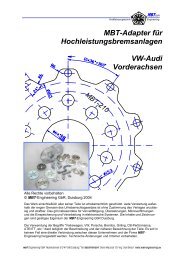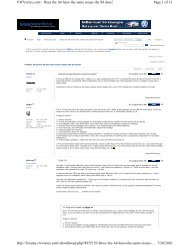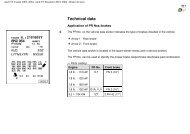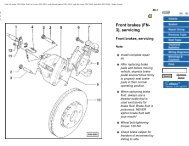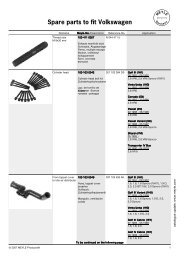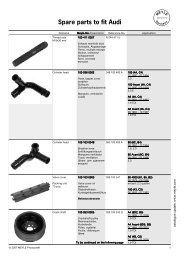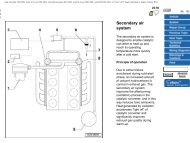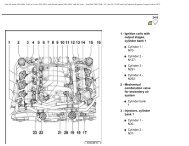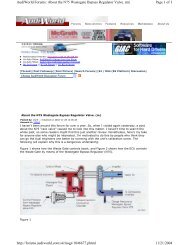VW MKII A2 MK2 Golf Jetta Fox Service Manual - VAGLinks.com
VW MKII A2 MK2 Golf Jetta Fox Service Manual - VAGLinks.com
VW MKII A2 MK2 Golf Jetta Fox Service Manual - VAGLinks.com
Create successful ePaper yourself
Turn your PDF publications into a flip-book with our unique Google optimized e-Paper software.
11•4 Bodywork and fittings<br />
6.2 Bonnet hinge 6.3 Disconnecting windscreen washer<br />
tubes from bonnet<br />
used. At one time the use of a universal paint<br />
was not possible owing to the <strong>com</strong>plex range<br />
of plastics encountered in body <strong>com</strong>ponent<br />
applications. Standard paints, generally<br />
speaking, will not bond satisfactorily to plastic<br />
or rubber, but a proprietary paint to match any<br />
plastic or rubber finish can be obtained from<br />
dealers. However, it is now possible to obtain<br />
a plastic body parts finishing kit which<br />
consists of a pre-primer treatment, a primer<br />
and coloured top coat. Full instructions are<br />
normally supplied with a kit, but basically the<br />
method of use is to first apply the pre-primer<br />
to the <strong>com</strong>ponent concerned and allow it to<br />
dry for up to 30 minutes. Then the primer is<br />
applied and left to dry for about an hour<br />
before finally applying the special coloured<br />
top coat. The result is a correctly-coloured<br />
<strong>com</strong>ponent where the paint will flex with the<br />
plastic or rubber, a property that standard<br />
paint does not normally possess.<br />
4 Major body damage - repair<br />
5<br />
Where serious damage has occurred, or<br />
large areas need renewal due to neglect, it<br />
means that <strong>com</strong>plete new panels will need<br />
welding in. This is best left to professionals. If<br />
the damage is due to impact, it will also be<br />
necessary to check <strong>com</strong>pletely the alignment<br />
of the bodyshell. This can only be carried out<br />
accurately by a <strong>VW</strong> dealer using special jigs. If<br />
the body is left misaligned, it is primarily<br />
dangerous as the vehicle will not handle<br />
properly and secondly, uneven stresses will<br />
be imposed on the steering, suspension and<br />
possibly transmission, causing abnormal wear<br />
or <strong>com</strong>plete failure, particularly to items such<br />
as the tyres.<br />
5 Door rattles - tracing and<br />
rectification 1<br />
1 Check first that each door is not loose at its<br />
hinges and that the latch is holding the door<br />
firmly in position.<br />
2 Check that each door lines up with the<br />
aperture in the vehicle body. Adjust the door if<br />
out of alignment.<br />
3 If a latch is holding its door in the correct<br />
position but the latch still rattles, then the lock<br />
mechanism is worn and should be renewed.<br />
4 Other rattles from the door could be caused<br />
by loose glass channels or wear in the window<br />
operating or interior lock mechanisms.<br />
6 Bonnet - removal, refitting<br />
and adjustment 2<br />
1 Support the bonnet in its open position and<br />
place some cardboard or rags beneath the<br />
corners by the hinges.<br />
2 Mark the location of the hinges with a pencil<br />
then loosen the four retaining bolts (see<br />
illustration).<br />
3 Where applicable, disconnect the<br />
windscreen washer tubes from the jets on the<br />
bonnet (see illustration).<br />
4 With the help of an assistant, release the<br />
stay, remove the bolts and withdraw the<br />
bonnet from the vehicle.<br />
5 Refitting is a reversal of removal. Adjust the<br />
hinges to their original positions and check<br />
that the bonnet is level with the surrounding<br />
bodywork.<br />
6 If necessary, adjust the height of the bonnet<br />
front edge by screwing the rubber buffers in<br />
or out (see illustration).<br />
7 Check that the bonnet lock operates in a<br />
satisfactory manner.<br />
7 Bonnet lock and release<br />
cable - removal and refitting 2<br />
Bonnet lock<br />
6.6 Bonnet rubber buffer<br />
1 The bonnet lock is not adjustable for<br />
position and is secured to the front cross<br />
panel by four pop-rivets (see illustration). To<br />
remove the lock, disconnect the lock release<br />
cable then carefully drill down through the<br />
rivets and withdraw the lock.<br />
2 Refit the lock by reversing the removal<br />
procedure. Ensure that the new pop-rivets<br />
secure the lock firmly.<br />
Release cable<br />
3 To remove the bonnet lock release cable,<br />
raise and support the bonnet then remove the<br />
radiator grille.<br />
4 Reaching through the aperture in the front,<br />
press the release to one side and disconnect<br />
the cable from it (see illustration). Release<br />
the cable from the retaining clip on the<br />
underside of the front panel.<br />
5 Unclip the cable from the retainers in the<br />
engine <strong>com</strong>partment.<br />
6 Detach the cable from the release handle<br />
inside the vehicle and pull the cable through<br />
the bulkhead grommet and remove it.<br />
7 Refit the cable in the reverse order to<br />
removal. Check for satisfactory operation of<br />
the catch before closing the bonnet.<br />
8 If the cable should break with the bonnet<br />
shut, it is possible to release the catch by<br />
7.1 Bonnet lock and securing rivets 7.4 Bonnet release cable-to-lock<br />
attachment<br />
1081 <strong>VW</strong> <strong>Golf</strong> & <strong>Jetta</strong>



